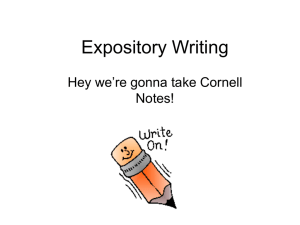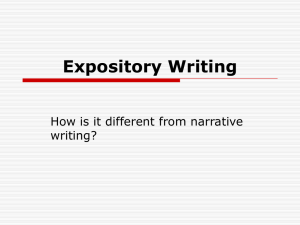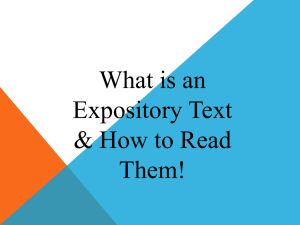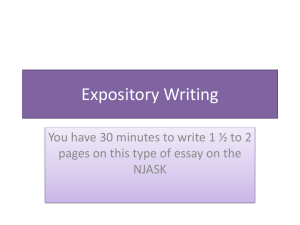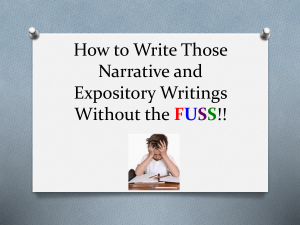Day 4 Power Point
advertisement
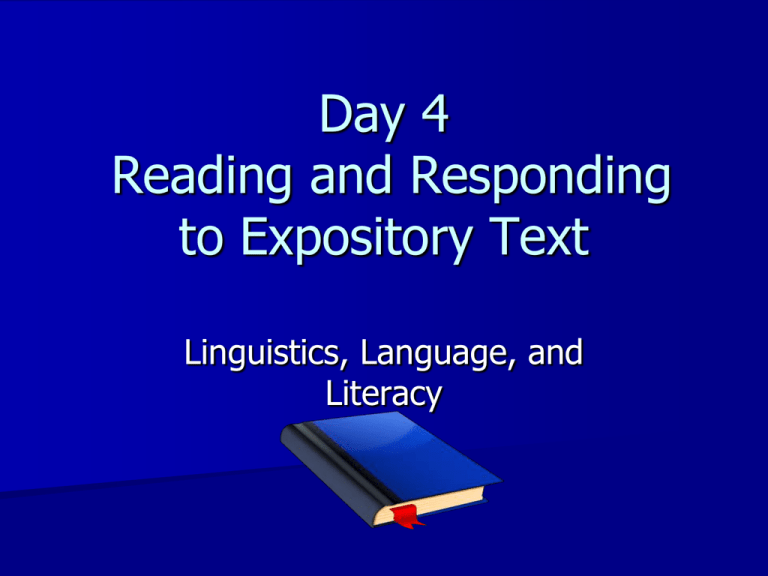
Day 4 Reading and Responding to Expository Text Linguistics, Language, and Literacy Day 4 Schedule Welcome/Warm up Activity Learning Styles Activity Expository Text Define Standards Trace The Reading Process Pre-Reading/Skimming Annotation Outlining Summarizing/Reviewing Reading Process Activity “Justin Lebo” Expository Text/Read “New Jersey Abolishes the Death Penalty” “A Cowboys Life” Morning Review CUBE IT The Cube The person whose birthday comes closest the January 1st rolls the cube . Answer the question that appears on the top. Two people may respond to your thoughts Pass the cube to the right. Bloom’s Taxonomy Explanation of each level What type of learner are you? Your learning style really matters when you are attempting something new. Knowing the type of learner you are as a teacher will help you in a variety of ways… Learning Styles are Important Teachers can……. Utilize the information to tailor lesson plans that are interactive. Create interesting and motivating classroom discussions. Match teaching and learning styles to improve performance. Motivate students according to their interests. Provide a more meaningful dialogue with parents. Discover the power of working on teams. Standards Trace Reading 2.0 Identify the academic language (Verb) List the “what” next to the verb How might you be able to use this strategy in your lesson planning? With students? What is expository writing ? Expository writing is a type of written discourse that is used to: explain describe give information inform The creator of an expository text can not assume that the reader or listener has prior knowledge or prior understanding of the topic that is being discussed. Expository Writing One important point to keep in mind for the writer of an expository work is the importance of using: Key vocabulary that clearly expresses the information the writer is providing for the reader. In addition to this, a key component in expository writing is the organization of the essay. Expository Organizational Patterns As we begin to explore both oral and written exposition we find that there are eight different examples of expository organizational patterns. Most of these organizational patterns will be familiar to you. You may have never really considered them to be "kind" of organizational patterns. Circumlocution Depicts a pattern in which the speaker discusses a topic, then diverts to discuss a related but different topic. Expository Writing Organizational Patterns Cause and Effect- The author lists one or more causes and the resulting effect or effects. Problem and Solution- The author states a problem and lists one or more solutions for the problem. A variation of this pattern is the question- and-answer format in which the author poses a question and then answers it. Narrative Interspersion A pattern or a sub-pattern imbedded in other patterns in which the speaker or writer intersperses a narrative within the expository text for specific purposes, including to clarify, or elaborate on a point or to link the subject matter to a personal experience. Recursion When the speaker discusses a topic, then restates it using different words or symbolism. It is used to drive home a point and to give special emphasis to the text. Expository Writing Organizational Patterns Description- The author describes a topic by listing characteristics, features, and examples. Sequence- The author lists items or events in numerical or chronological order. Comparison The author explains how two or more things are alike and/or how they are different. What are Pre-reading Activities? To be beneficial our reading must be carefully directed. The information we have before a reading will affect how we understand what we have read. Prereading strategies help to activate a students prior knowledge. Pre-Reading Activities Brainstorm possible scenarios about the story from reading the title. Use a topic related to the story to have a class discussion before the reading of the story takes place. Mind map the title or subject to help engage students in a proper mind set for the reading that will take place. Pre-Reading Activities Use pictures and other visual materials to activate students prior knowledge. Advanced organizers relate new reading material to a previous experience or background. Set a purpose for reading Vocabulary Previews Use a KWL chart to organize information Annotating text Annotating text helps to improve students comprehension by teaching them to note the main ideas and details in a particular piece of text. This technique helps increase students attention to text and increases their memory of important information and details. There are several strategies for marking or annotating text. Mark It Once The mark it once strategy helps students identify a paragraphs important details. Ask students to mark one word in the paragraph that will help them remember an important detail in the paragraph. Let’s Practice… Circle Once, Underline Twice In this activity students read each paragraph and circle one important word or phrase. Have them underline two other terms that support/explain the circled text. Pick a Number The purpose of the Pick a Number strategy is to teach students to limit their highlighting and underlining by identifying key words and information. Before students read have them pick a number between 8 and 15. Students must mark only this number words and phrases. They must choose terms from the entire text. They must justify their choices by writing a one sentence summary. Text to Use for Annotating Practice Newspapers Magazines Directions in workbooks Old textbooks Brochures Advertisements E-mail Articles from the internet Student school magazines Student work Photocopied material Junk mail Annotating Text Let’s practice: Each participant will be given a variety of materials find an appropriate article to annotate the text . Be prepared to share how this strategy will support learners. Outlining Summarizing and Reviewing Summaries and outlines help students to retain key pieces of information from the text. Outlining specifically helps students to organize the information so that it flows from beginning to end. Summarizing helps students to retain key facts, delete information that is unimportant, and report main ideas and key concepts from a piece of text. Justin Lebo Story Vocabulary Yield Give way to pressure or force Realign To re-adjust into a straight line or into proper coordination. Interchangeable To put each in the place of the other or to change places mutually. Determined To bring about a result. To fix conclusively or authoritatively Coalition Association or organization formed for a specific purpose usually for a temporary amount of time. Justin Lebo Today’s story is going to be about a boy who’s hobby turned into an opportunity to help others. Quick Write: Tell about a hobby that you have and discuss how it could possibly help others. Time to Share Quick Writes In small groups of 4 each person will share their quick write. The group will select the best one and that person will share theirs with the whole group. Independent Activity As you read the story about Justin Lebo use ONE of the following pre-reading activities: Mark it Once Circle Once ,Underline Twice Pick a Number Annotating Text Discuss with a Partner What you learned from notating the text as you read. What are some key ideas or concepts you learned from the story? What makes this story important for students? Summary/Outline Goals The learner will be able to: Independently write a summary or an outline of the story Justin Lebo. Include a reflection as to how this story applies to life. Prepare to share writing with a partner. Summary Select one of the summary graphic organizers. Complete the graphic organizer for Justin Lebo Be prepared to share Debrief Explain to your table why you selected this graphic organizer. What would be the value of offering a variety of graphic organizers? Expository Text Reading Quick Write Preview Vocabulary Read article independently Idea Wave Use a summary template New Jersey Death Penalty Give some reasons why a state would decide to abolish it’s death penalty? Article Specific Vocabulary Abolish Execute Sentence Lethal injection Parole Irreversible High Use Vocabulary Legislature Commission Affect Appeal Investigate Lab (Laboratory) Conflicting New Jersey Death Penalty Read the article about the New Jersey Death Penalty Use a pre-reading strategy Be prepared to share one word that summarizes your reaction to the article Idea Wave An idea wave is a strategy used to share information in a large group. In a particular order across the room participants will share one word about the topic. It is meant to go rapidly, there will be time for discussion later. Writing Summary Template The summary template is a Kate Kinsella strategy. It helps students to organize and report expository information using appropriate transitions. After completing your summary template be prepared to share how this will be useful in your classroom. Pre-reading activity for A Cowboy Tale… Listen to the First Paragraph of the story… A Cowboy Tale… What is the author’s purpose ? A Cowboy Tale… Who is in charge of a cattle drive? Explain the roles of each job. A Cowboy Tale… What are two dangers cowboys face? The Real Story of …. A Cowboy’s Life Geoffrey C. Ward Use the Graphic Organizer to Interact with the text…. What the text says…. What I know…. What can you infer? Gallery Walk Let’s take a look at the strategies that we have used in today’s work shop…….. Day 4 Wrap-up Final Comments Independent Study – Write a lesson plan that includes the standards and strategies for Reading Expository text – Be sure to include all student handouts and text Evaluation
